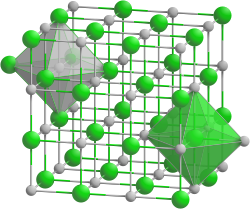Lithium iodide
| Crystal structure | ||||||||||||||||
|---|---|---|---|---|---|---|---|---|---|---|---|---|---|---|---|---|

|
||||||||||||||||
| __ Li + __ I - | ||||||||||||||||
| Crystal system |
cubic |
|||||||||||||||
| Space group |
Fm 3 m (No. 225) |
|||||||||||||||
| Coordination numbers |
Li [6], I [6] |
|||||||||||||||
| General | ||||||||||||||||
| Surname | Lithium iodide | |||||||||||||||
| other names |
Lithium iodide |
|||||||||||||||
| Ratio formula | LiI | |||||||||||||||
| Brief description |
white, odorless solid |
|||||||||||||||
| External identifiers / databases | ||||||||||||||||
|
||||||||||||||||
| properties | ||||||||||||||||
| Molar mass | 133.85 g mol −1 | |||||||||||||||
| Physical state |
firmly |
|||||||||||||||
| density |
3.49 g cm −3 (25 ° C) |
|||||||||||||||
| Melting point |
446 ° C |
|||||||||||||||
| boiling point |
1171 ° C |
|||||||||||||||
| solubility | ||||||||||||||||
| Refractive index |
1,955 |
|||||||||||||||
| safety instructions | ||||||||||||||||
|
||||||||||||||||
| Thermodynamic properties | ||||||||||||||||
| ΔH f 0 |
−270.08 kJ mol −1 |
|||||||||||||||
| As far as possible and customary, SI units are used. Unless otherwise noted, the data given apply to standard conditions . Refractive index: Na-D line , 20 ° C | ||||||||||||||||
Lithium iodide , LiI is the lithium salt of hydriodic acid . In addition to the anhydrous lithium iodide, there are also various hydrates , known are LiI · nH 2 O with n = 0.5, 1, 2 and 3.
Extraction and presentation
Lithium iodide is produced by reacting aqueous lithium hydroxide or lithium carbonate solutions with hydrogen iodide , followed by concentration and drying.
The anhydrous lithium iodide can also be prepared by reacting lithium hydride with iodine in anhydrous diethyl ether .
properties
Lithium iodide forms colorless, highly hygroscopic crystals with a melting point of 446 ° C, a boiling point of 1180 ° C and a density of 3.49 g cm −3 . The molar mass of the anhydrous lithium iodide is 133.85 g / mol. The oxidation of iodide to iodine by air oxygen causes the crystals to quickly turn yellowish to brownish in color.
The trihydrate has a melting point of 73 ° C. When heated, it loses two molecules at 80 ° C and another molecule of crystal water at 300 ° C. Lithium iodide is readily soluble in water (1650 g / l water at 20 ° C) and ethanol.
The standard enthalpy of formation of crystalline lithium iodide is Δ f H 0 298 = −270.08 kJ / mol.
use
The anhydrous lithium iodide is used for organic syntheses, in lithium iodine batteries it serves as an electrolyte . Doped crystals serve as a scintillation detector for slow neutrons .
Individual evidence
- ↑ a b c d e f g h Entry on lithium iodide in the GESTIS substance database of the IFA , accessed on January 8, 2020(JavaScript required) .
- ↑ Dimethyl Sulfoxide (DMSO) Solubility Data. Gaylord Chemical Company, LLC; Bulletin 102, June 2014, p. 14. (PDF)
- ^ G. Milne: Gardner's Commercially Important Chemicals: Definitions, Trade Names, and Properties. P. 370, Wiley-IEEE, 2005, ISBN 9780471736615 .
- ↑ David R. Lide (Ed.): CRC Handbook of Chemistry and Physics . 90th edition. (Internet version: 2010), CRC Press / Taylor and Francis, Boca Raton, FL, Index of Refraction of Inorganic Crystals, pp. 10-246.
- ↑ Entry on lithium iodide (Condensed phase thermochemistry data). In: P. J. Linstrom, W. G. Mallard (Eds.): NIST Chemistry WebBook, NIST Standard Reference Database Number 69 . National Institute of Standards and Technology , Gaithersburg MD, accessed November 17, 2019.
- ^ A b c d A. F. Holleman , E. Wiberg , N. Wiberg : Textbook of Inorganic Chemistry . 101st edition. Walter de Gruyter, Berlin 1995, ISBN 3-11-012641-9 , pp. 1151-1152.
- ↑ MD Taylor, LR Grant: New Preparations of Anhydrous Iodides of Groups I and II Metals , in: J. Am. Chem. Soc. 1955 , 77 , 1507-1508
- ^ GF Hüttig, F. Pohle: Studies on the chemistry of lithium. II. About the hydrates of lithium iodide , in: Z. anorg. allg. Chem. 1924 , 138 , 1-12.
- ↑ Oliver Herzberg: Investigation of organic solid-state reactions using the example of substitution and polycondensation reactions , dissertation, University of Hamburg 2000. DNB 960245774/34
- ↑ LF Trueb, P. Rüetschi: Batteries and accumulators - Mobile energy sources for today and tomorrow. , Springer, Berlin 1998 ISBN 3-540-62997-1 .
- ↑ KP Nicholson: Some lithium iodide phosphors for slow neutron detection , in: J. Appl. Phys. 1955 , 6 , 104-106.




